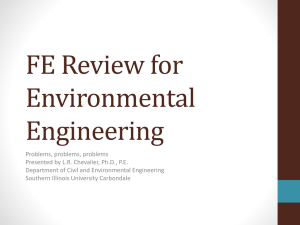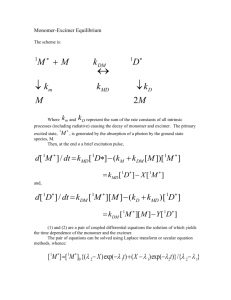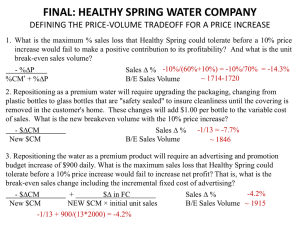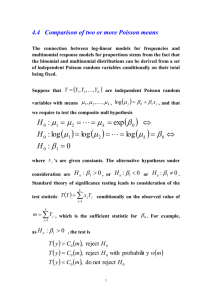Lecture 2 (1/16/13) "Introduction and the 4 Macromolecules of Life"
advertisement
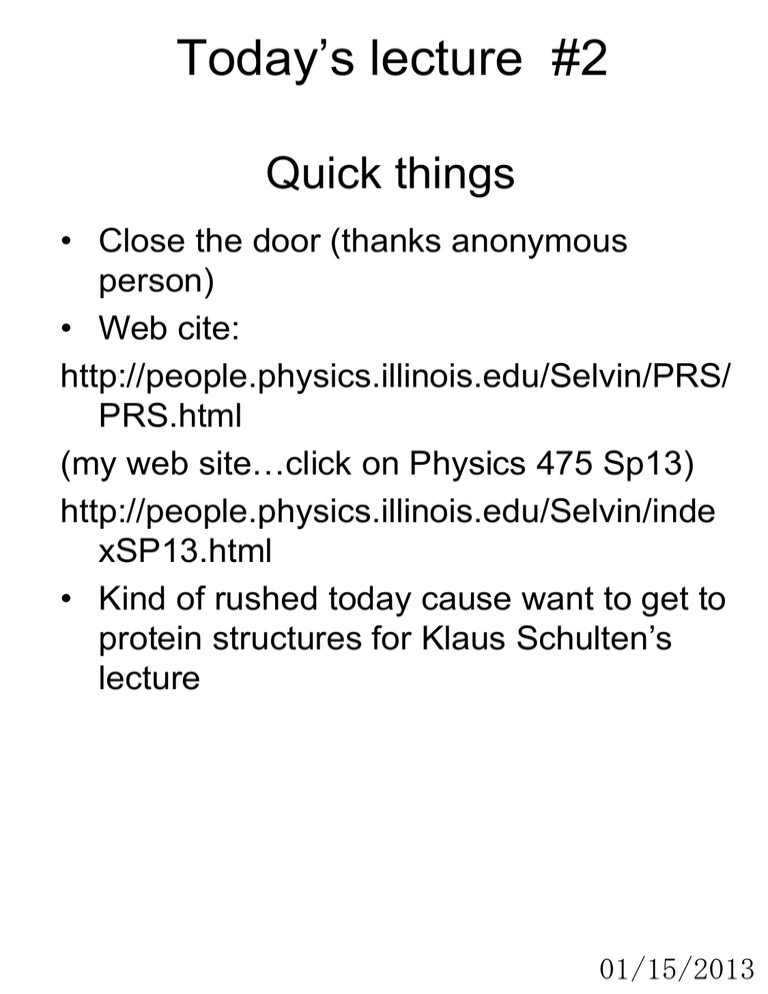
Today’s lecture #2 Quick things • Close the door (thanks anonymous person) • Web cite: http://people.physics.illinois.edu/Selvin/PRS/ PRS.html (my web site…click on Physics 475 Sp13) http://people.physics.illinois.edu/Selvin/inde xSP13.html • Kind of rushed today cause want to get to protein structures for Klaus Schulten’s lecture 01/15/2013 Questions from last Lecture • Liked King Kong • Could he have existed? No • Quantum Mechanics Not really relevant, Although Heisenberg Uncertainty Principle and theory of fluorescence/light is somewhat relevant. • Topics of written/oral --you choice, although most likely should be from Science, Nature, Cell. See handout on Web page. Today’s lecture • • • • Temperature of earth: Greenhouse Effect What is Life? ∆G and ∆E stability of molecules The 4 types of macromolecules Nucleic Acids, Proteins, Carbohydrates, Lipids • Central Dogma of Molecular Biology • DNA • Protein Structure Is there water-based life on other planets? Example of physical limits to life. Idea: For water-based life, 0º < Tave < 100ºC Can we calculate Tave of planets in our solar system? Earth What determines (surface) temp? Answer: Heat (photons) from sun How much light? Ie= 1.35 kW/m2 1 meter 1 meter How many (flood)lights? # Floodlight ~ 30 (1 meter away) (Incandescent light 3% efficient) Why determines earth temperature? Why can life exist? Temp of earth constant Heat in = Heat out Heat In (Absorbed) = (1-a)IepRe2 a= reflectivity of object aearth ≈ 0.3 = Heat Out = aσ T4 x (surface area) σ = const (=5.7 x 10-8 W/m20k4) T = absolute Temp. (Stefan-Boltzmann Law) Kittel, Thermal Physics pg 91-96 (1-a)IepRe2 = (aσT4)(4pRe2) (1- a )I e 4s Heat out Heat in [Note: Re2 cancel] é (1- 0.3)1350W /m 2 ù ú = Te 4ê -8 2 4 = T ë (4)(5.7 ´10 w/m k ) û 1/4 = 253° K = -15 ˚C Too cold! Actual <Te> = 288 ° K = 15 ˚C If Earth had no atmosphere the global average surface temperature would be -15˚C. With an atmosphere, temp is actually would be ≈15˚C. Conclusions of calculations Temp of earth primarily determined by sun’s photons, not earth’s mantle. Calculation off because of Greenhouse effect: earth has an atmosphere. Heat out Heat in Sun Earth You calculate what temperature should be! Boltzmann factor & Degeneracy • Generalize the definition of the free energy to include degeneracy. Like flipping a deck of cards twice. • Each energy level may be populated with several molecules, i.e. have many accessible states. We define the multiplicity Wi as the number of accessible states with energy Ei. For example: W=3 W=2 W=3 W=2 3 2 1 0 Assume that a more general formula for the probability P(Ei, Wi) = (Wi/Z) e-Ei/kT of finding a molecule with energy Ei, with the multiplicity factor Wi. Using Wi = exp[ln Wi] ; and later define S= kln[Wi]; G= E-TS P(Ei, Wi) = (Wi/Z) exp(-Ei/kT) = (1/Z) [exp(lnWi)] exp(-Ei/kT) = (1/Z) exp -(Ei – kTlnWi)/kT Define S= kln[Wi] P(Ei, Wi) = (1/Z) exp -(Ei – TS)/kT = = (1/Z) exp –(Fi )/kT where F = Helmholtz free energy which is same as Gibb’s Free Energy for liquids (non-gasses). Note: ∆G because always energy w.r.t. some zero (like E, ∆E); define E and S. Typically, 1M concentration. Equilibrium How stable is one state over another? A B Probability of being in B = Z-1exp(-GB/kT) Probability of being in A = Z-1(exp-GA/kT) Keq = B/A = exp (-GB/kT+ GA/kT) = exp –([GA- GA]/kT)= exp –(∆G/kT) ∆G = -kTlnKeq Stability and thermal activation Both systems are stable because they have activation energy to convert! All chemical reactions involve changes in energy. Some reactions release energy (exothermic) and others absorb it (endothermic). Keq= [B]/[A] [Says nothing about ∆G+rev/forward] ∆G+forward ∆G+rev Keq = f(∆G)? Keq = exp(-∆G/kT) ∆G ∆G = -kT ln (Keq) Enzymes (Catalyst) ∆G+rev ∆G+forward ∆G If Activation Energy < kT, then rxn goes forward. If not, need to couple it to external energy source (ATP). Breaking down a polymer How you get energy/ Why you eat. (b) Hydrolysis: breaking down a polymer High energy Einitial 1 2 3 4 Hydrolysis adds a water molecule, breaking a bond. Low(er) energy 1 Efinall 2 Gives (free) Energy (Efinal < Einitial; Sfinal > Sinitial) 3 Carbohydrate—polymer You eat food, break it down into smaller pieces and you gain energy Both systems are stable cause they have activation energy to convert! Forming/breaking down a polymer (a) Dehydration reaction: synthesizing a polymer 1 2 3 Short polymer Unlinked monomer Dehydration removes a water molecule, forming a new bond. 1 2 3 4 Takes (free) Energy (ATP) (Efinal> Einitial; Sfinal< Sinitial) Longer polymer Efinal= Einitial + ATP + heat You live by taking some energy (in the form of a small molecule ATP, Adenosine TriPhosphate, whose energy ultimately comes from food, which gets energy from the Sun) and building up polymers. Need to know Chemical Bonding 4 types 1. Covalent – 100kT. Sharing of electrons. C-H Is light enough to break covalent bond? 1um =1eV; kT=1/20eV. 1um= 20kT: close (yup) 2. Ionic - varies tremendously, 100kT to few kT. + and – attract, but depends on solvent. Na+ Cl- = few kT (break up easily) 3. Hydrogen – few kT, up to 5kT 1. Hydrogen attached to a very electro-negative elements, (O, N) causing the hydrogen to acquire a significant amount of positive charge. 2. Lone pair– electrons in relatively small space, very negative. Result is H is (+) and O is (-). Will bind to other molecules 4. Van der Waals –kT (weakest, but many of them together--significant). Two neutral atoms have instantaneous dipoles, and attract. Neon: -246°C; Xenon: 108°C www.chemguide.co.uk/atoms/bonding/hbond.html#top Break time! Somebody wrote: “It’s very funny to meet random people in class” so do like last time… 4 minutes (2 min per person) With someone you don’t know, Find out their: 1.Name, Year, undergrad vs. grad. 2.Why you’re taking the course. 3.Tell one thing that’s surprising. A few people will have to report! 4 Large [Macro]Molecules (from small molecules) Biological polymers (Large molecule made from many smaller building block) • • • • DNA & RNA Nucleotides Proteins Amino Acids Carbohydrates Sugars Fats (also called Lipids) Fatty acids Each is used to: a. Make macromolecules/structural b. Energy Source c. Information– Storage/signaling DNA & RNA ; ATP; Genetic Information Proteins; break down yields energy; nerve impulses. : The 4 types of macromolecules Proteins DNA (RNA) Lipids (Fat) Carbohydrates Protein Structu • Primary --20 different amino acids • Secondary • Tertiary (single polypep Quaternary– multiple polypeptides Myoglobin- 1 Linear sequence of ~ 20 amino acids Can get enormous diversity and function with Proteins Figure 5.20b 4 Different layers of Protein Structure Tertiary structure Secondary structure Quaternary structure a helix Hydrogen bond pleated sheet ( arrow toward carboxyl end) strand Hydrogen bond Transthyretin polypeptide Transthyretin protein Minimal knowledge about Nucleotides • 4 nucleotides: A,T,G,C • A=T ≈ 2kT two hydrogen bonds G=C ≈ 4kT three hydrogen bonds [More Next time] Homework #1 Assigned! Due at beginning of class Jan. 23, 2013 [also read Chpt 1 of Phillips et al. Evaluate class 1. What was the most interesting thing you learned in class today? 2. What are you confused about? 3. Related to today’s subject, what would you like to know more about? 4. Any helpful comments. Put your name in upper right-corner. Then tear off your name before turning in. (That way you can be brutally honest!) Answer, and turn in at the end of class. (I’ll give you ~5 minutes.)




